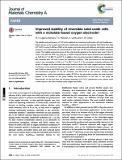Por favor, use este identificador para citar o enlazar a este item:
http://hdl.handle.net/10261/148405COMPARTIR / EXPORTAR:
 SHARE SHARE
 CORE
BASE CORE
BASE
|
|
| Visualizar otros formatos: MARC | Dublin Core | RDF | ORE | MODS | METS | DIDL | DATACITE | |

| Título: | Improved stability of reversible solid oxide cells with a nickelate-based oxygen electrode |
Autor: | Laguna-Bercero, M. A. CSIC ORCID ; Monzón, Hernán CSIC; Larrea, A. CSIC ORCID ; Orera, V. M. CSIC ORCID | Fecha de publicación: | 2016 | Editor: | Royal Society of Chemistry (UK) | Citación: | Journal of Materials Chemistry A 4(4): 1446-1453 (2016) | Resumen: | The stability and performance of YSZ (yttria stabilized zirconia) based solid oxide cells with Ruddlesden-Popper phases as the oxygen electrode have significantly improved. Microtubular Solid Oxide Fuel Cells (mT-SOFCs) using PrNiO (PNO) as the oxygen electrode along with different electrolyte-electrode interlayers were fabricated and characterized in both fuel cell (FC) and electrolysis (SOEC) operation modes. The stability and performance of the cells strongly depend on the barrier layer used. In the FC mode, cells with the PNO-CeGdO (CGO) composite barrier layers showed power densities of ca. 0.63 W cm at 800 °C and 0.7 V. In addition, they presented excellent stability as no degradation was observed after 100 hours under the operating conditions. Their performance in the electrolysis mode is also remarkable (-0.78 A cm at 800 °C and 1.3 V). As anticipated, nickelates withstand the excess of oxygen at the electrode-electrolyte interface better than other oxygen electrode materials. Oscillatory current behaviour has been observed and ascribed to the partial decomposition reaction of the PrNiO phase into PrNiO and PrO which, on the other hand, seems not to deteriorate the electrochemical properties of the cell. However, the PNO-CGO in situ reaction, forming mixed praseodymium, cerium and gadolinium oxides (PCGO) at the electrolyte-oxygen electrode interface, appears to be essential for the good stability and performance of the cells. In this study we demonstrate, for the first time, the excellent reversible SOFC/SOEC performance and stability under current load of a cell with nickelate based oxygen electrodes. | Versión del editor: | https://doi.org/10.1039/c5ta08531d | URI: | http://hdl.handle.net/10261/148405 | DOI: | 10.1039/c5ta08531d | Identificadores: | doi: 10.1039/c5ta08531d e-issn: 2050-7496 issn: 2050-7488 |
| Aparece en las colecciones: | (ICMA) Artículos |
Ficheros en este ítem:
| Fichero | Descripción | Tamaño | Formato | |
|---|---|---|---|---|
| oxygenelectrode.pdf | 859,96 kB | Adobe PDF |  Visualizar/Abrir |
CORE Recommender
SCOPUSTM
Citations
86
checked on 01-abr-2024
WEB OF SCIENCETM
Citations
76
checked on 21-feb-2024
Page view(s)
308
checked on 18-abr-2024
Download(s)
309
checked on 18-abr-2024
Google ScholarTM
Check
Altmetric
Altmetric
Este item está licenciado bajo una Licencia Creative Commons

